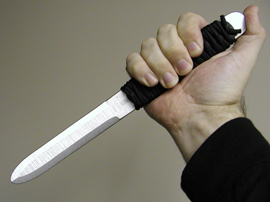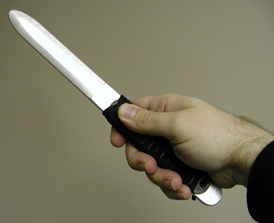To wield a knife effectively for self-defense, you must be trained in its use. There are a number of different ways to seek out knife training for self-defense: you can train yourself, you can find a knowledgeable friend, you can take seminars, are you can enroll in a martial art specifically geared towards weapons instruction.
 To train yourself requires a great commitment to amassing a large library of video of text references, spending time on solo training drills, and praying a lot. This is the least desirable means of teaching yourself knife defense, because it’s very easy to get into bad habits or believe in faulty and unworkable concepts. There are a lot of very good instructional tapes and books on the topic of knife fighting available from Paladin Press
To train yourself requires a great commitment to amassing a large library of video of text references, spending time on solo training drills, and praying a lot. This is the least desirable means of teaching yourself knife defense, because it’s very easy to get into bad habits or believe in faulty and unworkable concepts. There are a lot of very good instructional tapes and books on the topic of knife fighting available from Paladin Press
and Delta Press, fortunately, but among these tapes is also a lot of garbage. Shop intelligently, compare, and do as much research as possible to educate yourself.
Learning from someone else is a much better alternative, provided that individual knows what he or she is doing. Again, you’ll have to use your best judgment and combine the training with the
information you can obtain from other sources.
Knife seminars and classes, when you can find them, are excellent resources for training. Organizations like Suarez International, Alliance Martial Arts, ComTech, Gunsite, CSSDSC, the Dog Brothers, and The Hochheim Group are just a few that offer these training opportunities. Resist the temptation to take a single seminar and declare yourself a knife-fighting expert, however.
If you find a martial art system that you enjoy, especially one whose primary focus is edged weapons, you have found an excellent resource for learning to defend yourself with a knife. Among the arts I would suggest — and this list is by no means inclusive — are Sayoc Kali, Amok!, Pekiti-Tirsia, and the Filipino Martial Arts in general,
Knife training, to be done properly, must be done safely. If you have not read it, I strongly suggest taking a look at my article, The Continuum of Trainers, which covers the use of rubber, plastic, wood, and metal training blades.
The key to any training with knives, of course — beyond the equipment used — is dedication, time, and practice. Proficiency with a blade will not happen overnight. Maintain reasonable goals and enjoy your study of these tools and weapons.
BASIC KNIFE GRIPS
A knife grip can be either a forward grip or a reverse grip. A forward grip is one in which the knife projects above the thumb. A reverse grip is one in which the knife projects below the thumb.

Reverse grip (with thumb capping).

Forward grip (a modified sabre).
In both cases the edge could be pointing away from the body or towards it. I have read accounts that claim Jim Bowie held his famous knife in a forward grip with the edge up, for example, to better carve up into his opponent. The advantage of holding the edge toward the body is that the knife, when held in a reverse grip with the edge in, can
be used for trapping and ripping.
There are many variations on the theme of grip, but here are the common ones:
Hammer Grip: This, the most basic of forward grips, is identical to the grip you would take on a hammer. It is the strongest of the forward grips.
Sabre Grip: This natural grip is similar to grasping a sabre. Jamming the thumb on a thrust is one danger of this grip.
Modified Sabre Grip: This is the sabre grip with the thumb held against the side of the handle rather than on top.
“Cancer” Grip: Instructor Hock Hochheim termed this the “cancer grip” because he believed it to be dangerous and
spreading quickly. The thumb is arched above the handle of the knife and used to point at targets. I believe this is a (misunderstood) variation on the use of the thumb for momentary trapping and pinching actions.
The Icepick Grip: This is the strongest of the reverse grips.
Reverse Grip: This is the Icepick Grip with a slight variation of the fingers. The thumb could be “capping” the pommel, or the knife itself could be held at a pronounced angle in the hand.
Capping is the practice of bracing the pommel of a knife with your thumb while holding the knife in a reverse grip.
Palming is the practice of bracing the pommel of a knife in your palm, to give the knife more reach or to protect your fingers from sliding onto the blade if the knife has no guard.
BASIC FALLACIES OF EDGED WEAPONS
1. If you carry a knife you’re a bloodthirsty maniac looking for trouble.
This statement is often made by hoplophobes (those who possess an irrational fear of tools and weapons). They view your ability to defend yourself, and the advantage possession of a weapon gives you, with fear and mistrust.
2. If you carry a weapon you’re insecure in your abilities.
The favored insult of those completely ignorant of weapons training, this statement betrays the speaker’s lack of knowledge on the subject. A weapon is an equalizer — one that allows an individual to prevail against multiple opponents, or to deliver the necessary force to a larger, stronger assailant who may have the element of surprise on his or her side. Carrying a weapon means you’re attempting to stack the deck in your favor — for all self-defense involves risk.
You can’t win every bet — but you can cheat as much as possible.
3. Your weapon will just be taken away and used against you.
The chances that a weapon will be taken from someone trained to use it are actually very low. If you are not prepared to use a weapon and are ignorant of its use, however, then yes — waving around such a thing will do you no favors. I refuse to adhere to the defeatist notion that we must never prepare ourselves for conflict on the theory that anything we do will simply work against us. That’s fatalistic stupidity in action, not prudence.
4. Such and such a knife in Length X is always (or never) legal.
You must check your local and state laws to find out what is legal for you. Even if you believe your knife is legal according to the letter of the law, your actions and your attitude will be a factor if a law enforcement officer stops you and discovers your blade. There are no guarantees.
5. Thrusts (or slashes) are always superior to slashes (or thrusts)
Unless your self-defense implement lacks a cutting edge, or has an edge but lacks a point, why would you eliminate valuable tools from your self-defense toolbox? Slashes and thrusts have their uses depending on context and circumstances. Do not dismiss one or the other out of hand.
6. Reverse grip is always (or never) superior to forward grip (or any other combination of grip X versus grip Y).
Again, why would you eliminate valuable tools from your self-defense toolbox? The various grips have their advantages and applications depending on context and circumstances. Do not dismiss a grip out of hand.
7. You can’t “defang the snake” — also known as, knife disarms never work.
This is defeatism. Knife disarms can work. The depend on speed and skill, but they are entirely possible. That doesn’t mean they’re not dangerous, however.
CONCLUSION
A knife is not the best self-defense weapon available. That distinction falls to the handgun, which represents the most effective means of defending your life and the lives of your family. Knives are, however, the best second choice in individual weaponry. To wield a knife for self-defense requires that you learn to use it, however. Simply owning the tool is not enough.
Train safely and often.